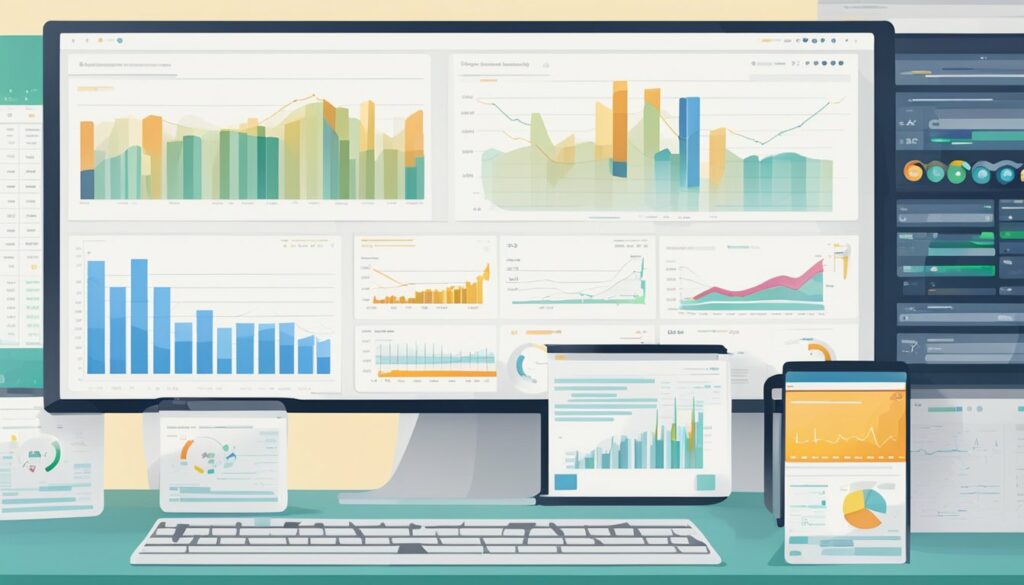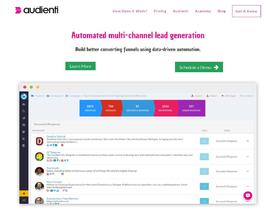How to stay on top of your online presence with search engine monitoring? To stay on top of your online presence with search engine monitoring, regularly track keyword rankings, analyze your site’s SEO performance, monitor competitor strategies, and adjust your content and SEO tactics based on data-driven insights. Keep an eye on algorithm updates and user engagement metrics for continual optimization.
Search engine monitoring is a crucial aspect of any successful SEO strategy. It involves keeping track of website rankings, traffic, and other metrics to ensure that the website is performing well on search engines.
With millions of websites vying for the top spot on Google, search engine monitoring has become an essential tool for businesses to stay ahead of the competition.

Understanding Search Engine Monitoring
Search engine monitoring involves tracking the performance of a website on search engines like Google, Bing, and Yahoo. It includes monitoring factors like website rankings, traffic, backlinks, and other metrics that can affect a website’s SEO performance. By keeping track of these metrics, businesses can identify areas where they need to improve their SEO strategies and make necessary changes.
Setting Up Monitoring Tools
To effectively monitor a website’s SEO performance, businesses need to set up monitoring tools. These tools can help track website rankings, traffic, and other key metrics. Some popular monitoring tools include Google Analytics, SEMrush, and Ahrefs. These tools provide businesses with valuable insights into their website’s SEO performance and help them make data-driven decisions to improve their rankings on search engines.
Key Takeaways
- Search engine monitoring is essential for businesses to stay ahead of the competition on search engines like Google.
- Understanding and tracking metrics like website rankings, traffic, and backlinks is crucial for optimizing SEO strategies.
- Setting up monitoring tools like Google Analytics, SEMrush, and Ahrefs can provide valuable insights into a website’s SEO performance.
Understanding Search Engine Monitoring
The Role of Search Engines in SEO
Search engines play a crucial role in the success of any website. They are the primary source of traffic for most websites, and therefore, optimizing a website for search engines is essential. Search Engine Optimization (SEO) is the process of improving the visibility of a website or a web page in search engine results pages (SERPs) through various techniques.
Google Search Console and Google Analytics are two essential tools that help website owners monitor their website’s performance on search engines. Google Search Console provides insights into how Google crawls and indexes a website, while Google Analytics provides data on website traffic and user behavior.
Key Concepts in Search Engine Monitoring
SEO monitoring involves tracking and analyzing a website’s performance on search engines. It includes monitoring keyword rankings, backlinks, traffic, and other metrics to identify areas for improvement. Here are some key concepts in search engine monitoring:
-
Keyword Rankings: Keyword rankings refer to a website’s position in search engine results pages (SERPs) for specific keywords. Monitoring keyword rankings helps website owners identify which keywords are driving traffic to their website and which ones need improvement.
-
Backlinks: Backlinks are links from other websites that point to a website. They are a crucial factor in determining a website’s authority and ranking on search engines. Monitoring backlinks helps website owners identify which websites are linking to their website and which ones need improvement.
-
Traffic: Monitoring website traffic helps website owners understand how users are interacting with their website. It includes metrics such as page views, bounce rate, and time on site.
In conclusion, search engine monitoring is an essential aspect of SEO. It helps website owners identify areas for improvement and optimize their website for search engines. By using tools such as Google Search Console and Google Analytics, website owners can gain valuable insights into their website’s performance on search engines. For more information on search engine monitoring, check out this article.
Setting Up Monitoring Tools
Monitoring search engine performance is a crucial aspect of any SEO strategy. By tracking the performance of your website in search engine results pages (SERPs), you can identify areas that need improvement and optimize your content to rank higher. Here are some ways to set up monitoring tools to track your website’s performance.
Using Google Search Console
Google Search Console is a free tool that allows you to monitor your website’s performance in Google search results. By verifying your website with Google Search Console, you can see which keywords your website is ranking for, the click-through rate (CTR) of those keywords, and any errors or issues with your website that may be affecting its performance.
To set up Google Search Console, you need to verify ownership of your website. Once you have verified ownership, you can access a wealth of data about your website’s performance in search results. You can also use the tool to submit sitemaps, identify crawl errors, and monitor backlinks to your website.
Leveraging Google Analytics for SEO
Google Analytics is a powerful tool that allows you to track website traffic and user behavior. By analyzing this data, you can identify areas where your website is performing well and areas where it needs improvement. You can also use Google Analytics to track the performance of your SEO campaigns and identify which keywords are driving the most traffic to your website.
To use Google Analytics for SEO, you need to set up conversion tracking and goal tracking. By setting up these tracking features, you can see which pages on your website are converting the most visitors and which keywords are driving the most traffic to those pages. You can also use Google Analytics to track the performance of your social media campaigns and identify which social media platforms are driving the most traffic to your website.
Integrating Third-Party SEO Tools
In addition to Google Search Console and Google Analytics, there are many third-party SEO monitoring tools available. These tools can provide additional data and insights into your website’s performance in search results.
Tools such as SEMrush, Ahrefs, and Moz offer a variety of features, including keyword research, backlink analysis, and competitor analysis. By using these tools, you can identify new keywords to target, track your website’s backlink profile, and see how your website stacks up against your competitors.
To integrate third-party SEO tools with your website, you need to sign up for an account and connect your website to the tool. Once you have connected your website, you can access a wealth of data about your website’s performance in search results.
Overall, setting up monitoring tools is an essential part of any SEO strategy. By tracking your website’s performance in search results, you can identify areas that need improvement and optimize your content to rank higher. With the right tools and data, you can achieve higher rankings and drive more traffic to your website. For more information on SEO monitoring tools, check out this article.
Analyzing SEO Performance
Analyzing SEO performance is a crucial step in ensuring that your website is achieving its goals and reaching its target audience. By evaluating traffic and user behavior, assessing rankings and visibility, and understanding keywords and content performance, you can gain valuable insights into the effectiveness of your SEO strategy.
Evaluating Traffic and User Behavior
One of the most important metrics to consider when analyzing SEO performance is traffic. By monitoring organic traffic, you can track the number of users who are visiting your website through search engines. This can help you identify trends and patterns in user behavior, as well as any issues that may be impacting your website’s performance.
In addition to traffic, it’s also important to consider user behavior. By analyzing metrics such as bounce rate, time on site, and pages per session, you can gain a better understanding of how users are interacting with your website. This can help you identify areas for improvement and optimize your website for better user engagement.
Assessing Rankings and Visibility
Another key aspect of analyzing SEO performance is assessing rankings and visibility. By monitoring keyword rankings, you can track how well your website is performing in search engine results pages (SERPs). This can help you identify opportunities for improvement and optimize your website for better visibility.
In addition to keyword rankings, it’s also important to consider overall visibility. By monitoring metrics such as impressions and click-through rate (CTR), you can gain a better understanding of how users are interacting with your website in search results. This can help you identify areas for improvement and optimize your website for better visibility.
Understanding Keywords and Content Performance
Finally, it’s important to understand how keywords and content are impacting your website’s performance. By analyzing metrics such as page views, time on page, and conversion rate, you can gain insights into how users are interacting with your website’s content. This can help you identify opportunities for improvement and optimize your website’s content for better performance.
One useful tool for analyzing keywords and content performance is Google Analytics. This powerful analytics platform provides a wealth of data and insights into how users are interacting with your website. By using Google Analytics to track metrics such as organic traffic, bounce rate, and conversion rate, you can gain valuable insights into the effectiveness of your SEO strategy.
External Resource
To learn more about how to analyze SEO performance, check out this article from Moz: How to Analyze Your SEO Performance Using Google Analytics. This in-depth guide provides step-by-step instructions for using Google Analytics to monitor and improve your website’s SEO performance.
Tracking and Measuring SEO Metrics

Effective search engine monitoring involves tracking and measuring various SEO metrics to determine the success of a website’s optimization efforts. By measuring these metrics, businesses can identify areas for improvement and adjust their strategies to achieve their goals.
Key Performance Indicators for SEO
Key performance indicators (KPIs) are essential metrics for measuring the success of SEO efforts. These metrics include:
- Bounce rate: the percentage of visitors who leave a website after viewing only one page.
- Click-through rate (CTR): the percentage of users who click on a link after seeing it in search results.
- Conversion rate: the percentage of visitors who take a desired action on a website, such as making a purchase or filling out a form.
- Impressions: the number of times a website appears in search results.
Tracking these metrics over time can help businesses determine whether their SEO efforts are successful.
Conversion Metrics and User Engagement
In addition to tracking KPIs, businesses should also measure conversion metrics and user engagement. Conversion metrics include:
- Average order value: the average amount spent per transaction.
- Customer lifetime value: the total amount a customer is expected to spend on a business over their lifetime.
- Return on investment (ROI): the amount of revenue generated from SEO efforts compared to the amount spent on those efforts.
User engagement metrics, such as time spent on site and pages per session, can also provide valuable insights into a website’s performance.
Technical SEO and Website Performance
Technical SEO and website performance are also critical components of search engine monitoring. Technical SEO involves optimizing a website’s structure and code to improve its search engine rankings. Website performance, including page speed and errors, can also impact a website’s search engine rankings.
Businesses should regularly monitor their website’s technical SEO and performance metrics to ensure their website is optimized for search engines and providing a positive user experience.
To learn more about tracking and measuring SEO metrics, check out this resource on SEO analytics from Moz, a leading authority on SEO.
Optimizing SEO Strategies

To ensure the success of a website, optimizing SEO strategies is crucial. By doing so, a website can improve its position in search engine rankings and attract more traffic. This section will cover three main areas of SEO optimization: content and on-page optimization, off-page SEO and backlink analysis, and mobile optimization and UX.
Content and On-Page Optimization
One of the most important aspects of SEO is content optimization. By creating high-quality content that is relevant and engaging to the target audience, a website can improve its search engine rankings. On-page optimization involves optimizing the website’s HTML code, meta tags, and other elements to make it easier for search engines to crawl and index the website.
To optimize content and on-page elements, it is important to plan a solid SEO strategy. This strategy should include keyword research, competitor analysis, and a plan for optimizing landing pages. By doing so, a website can ensure that its content is optimized for the right keywords and that its landing pages are designed to convert visitors into customers.
Off-Page SEO and Backlink Analysis
Off-page SEO involves optimizing elements outside of the website itself to improve search engine rankings. This includes building backlinks to the website from other high-authority websites, social media marketing, and other forms of online promotion.
To optimize off-page elements, it is important to analyze backlinks to the website. This can be done using various tools such as Ahrefs or SEMrush. By analyzing backlinks, a website can identify opportunities to build new backlinks and improve its overall link profile.
Mobile Optimization and UX
Mobile optimization and UX are becoming increasingly important for SEO. With more people accessing the internet on mobile devices, it is crucial for websites to be optimized for mobile users. This includes optimizing website design for smaller screens, ensuring fast load times, and providing a seamless user experience.
To optimize for mobile and UX, it is important to plan a solid strategy that includes optimizing website design and user experience. This can be done by analyzing user behavior and identifying areas for improvement. By doing so, a website can ensure that it is providing a positive user experience for all visitors, regardless of the device they are using.
In conclusion, optimizing SEO strategies is crucial for the success of any website. By focusing on content and on-page optimization, off-page SEO and backlink analysis, and mobile optimization and UX, a website can improve its search engine rankings and attract more traffic. By planning a solid SEO strategy and using the right tools and techniques, a website can achieve its SEO goals and succeed in the competitive online marketplace.
Here is a link to a high-authority resource on on-page SEO factors that can be used to optimize content and on-page elements.
Monitoring Competitors and Market Trends

Keeping an eye on competitors and market trends is essential for any business that wants to stay ahead in the search engine rankings. By monitoring competitors, businesses can identify areas where they can improve their own search engine optimization (SEO) strategies. Additionally, keeping an eye on market trends can help businesses stay ahead of the curve and adapt to changes in search engine algorithms.
Competitive Analysis and Benchmarking
One of the most effective ways to monitor competitors is through competitive analysis and benchmarking. This involves analyzing the strengths and weaknesses of competitors’ websites and comparing them to your own. By doing so, businesses can identify areas where they need to improve and areas where they are already excelling.
Competitive analysis can be done manually, by analyzing competitor websites and search engine rankings, or through the use of automated tools. These tools can help businesses identify keywords that competitors are ranking for and track changes in search engine rankings over time.
Adapting to Search Engine Algorithm Updates
Search engine algorithms are constantly changing, and businesses need to be able to adapt quickly in order to maintain their search engine rankings. By monitoring market trends and staying up-to-date on changes to search engine algorithms, businesses can adjust their SEO strategies accordingly.
One example of a major search engine algorithm update was Google’s “Medic” update in 2018, which focused on improving the quality of health-related content in search results. Businesses that relied heavily on health-related keywords and content were affected by this update and had to adjust their SEO strategies accordingly.
To stay up-to-date on changes to search engine algorithms, businesses can subscribe to industry newsletters and blogs, attend SEO conferences, and use tools that track changes in search engine rankings over time.
Overall, monitoring competitors and market trends is essential for businesses that want to stay ahead in the search engine rankings. By staying up-to-date on changes to search engine algorithms and adapting their SEO strategies accordingly, businesses can maintain their search engine rankings and attract more organic traffic to their websites.
Here is a helpful resource on competitive analysis and benchmarking for SEO.
Reporting and Actionable Insights

Creating SEO Reports
One of the most important aspects of search engine monitoring is creating reports that accurately reflect SEO progress. These reports should be able to track the success of campaigns, conversions, sales, clicks, SERPs, revenue, queries, and site content. By monitoring these metrics, SEO professionals can understand how their campaigns are performing and make data-driven decisions to improve their search engine rankings.
When creating SEO reports, it’s important to use formatting such as tables, lists, bold, and italic to help convey information to the reader. These reports should be easy to read and understand, even for those who may not be familiar with SEO. Additionally, it’s important to include actionable insights that can help improve search engine rankings.
One useful tool for creating SEO reports is Google Analytics. This free tool provides detailed data on website traffic, including the number of visitors, the pages they visit, and how long they stay on the site. By using Google Analytics, SEO professionals can gain valuable insights into their website’s performance and identify areas for improvement.
Translating Data into SEO Actions
Once SEO reports have been created, it’s important to translate the data into actionable insights. This involves analyzing the data and identifying areas where improvements can be made. For example, if a website is not ranking well for certain keywords, SEO professionals may need to optimize the site’s content to better target those keywords.
To translate data into SEO actions, it’s important to have a deep understanding of search engine algorithms and how they work. This requires a combination of technical knowledge and creative thinking. SEO professionals must be able to identify opportunities for improvement and develop strategies to capitalize on them.
One useful resource for learning more about search engine algorithms is Moz. This website provides a wealth of information on SEO best practices, including how to optimize content for search engines, how to build high-quality backlinks, and how to track SEO progress over time. By using resources like Moz, SEO professionals can stay up-to-date on the latest trends and best practices in the industry.
Overall, creating SEO reports and translating data into actionable insights is a critical part of search engine monitoring. By using tools like Google Analytics and resources like Moz, SEO professionals can stay on top of their campaigns and make data-driven decisions to improve their search engine rankings.
Advanced SEO Monitoring Techniques

Utilizing SERP Features
Monitoring search engine results pages (SERPs) is a crucial aspect of search engine optimization (SEO). Advanced SEO monitoring techniques involve keeping an eye on SERP features that can impact organic search traffic. SERP features include but are not limited to featured snippets, knowledge graphs, image packs, and local packs.
By monitoring these features, SEO professionals can optimize their content to target these features and improve their average position on the SERP. Additionally, monitoring SERP features can help identify opportunities to improve site content and structure.
One useful tool for monitoring SERP features is SEMrush, which allows users to track SERP features for specific keywords and domains. By analyzing SERP features, SEO professionals can gain insights into search intent and adjust their content to better match user needs.
Exploring User Intent and Search Behavior
Understanding user intent and search behavior is essential for effective SEO monitoring. By analyzing search queries and behavior, SEO professionals can optimize their content and site structure to better match user needs.
One approach to exploring user intent and search behavior is to conduct a site audit to identify areas for improvement. This can involve analyzing tags, meta descriptions, and content to ensure they are aligned with user intent and relevant search queries.
Another useful technique is to monitor social media and other online platforms for mentions of the brand or related keywords. By monitoring social media, SEO professionals can gain insights into user behavior and identify opportunities to improve content and engagement.
Finally, analyzing domain authority and conversion rate optimization (CRO) can provide valuable insights into user behavior and help optimize site structure and content. Tools such as Moz and Ahrefs can be used to monitor domain authority and identify opportunities to improve site performance.
Overall, advanced SEO monitoring techniques involve a comprehensive approach to analyzing crawling, organic search traffic, search intent, and user behavior. By utilizing these techniques, SEO professionals can optimize their content and site structure to improve search engine rankings and drive organic traffic.
For more information on advanced SEO monitoring techniques, check out this article.
Continual Improvement and SEO Auditing

Search engine monitoring is a continuous process that requires regular auditing to ensure that a website is performing optimally. Conducting regular SEO audits is crucial to identify and fix SEO issues that might be hindering the website’s performance. This section will discuss the importance of conducting regular SEO audits and the steps involved in identifying and fixing SEO issues.
Conducting Regular SEO Audits
To ensure that a website is optimized for search engines, it is essential to conduct regular SEO audits. An SEO audit is a comprehensive review of a website’s current SEO performance. It involves analyzing various aspects such as title tags, meta descriptions, PPC, indexing, marketers, sales funnel, site exit points, broken links, user behavior, time on page, backlink profile, organic search results, featured snippet, blog posts, images, and more.
Regular SEO audits help to identify any issues that might be hindering a website’s performance on search engines. By conducting an audit, webmasters can keep track of their website’s performance and make necessary adjustments to improve their website’s ranking.
Identifying and Fixing SEO Issues
Once an SEO audit is completed, the next step is to identify and fix any issues that might be hindering a website’s performance. Some of the common SEO issues that might be identified during an audit include broken links, duplicate content, slow page speed, poor backlink profile, and more.
To fix these issues, webmasters can use various tools such as Google Search Console, SEMrush, Ahrefs, and more. These tools help to identify the issues and provide suggestions on how to fix them. For instance, broken links can be fixed by redirecting them to the correct page, while duplicate content can be removed or rewritten.
In conclusion, conducting regular SEO audits is crucial to ensure that a website is performing optimally on search engines. By identifying and fixing SEO issues, webmasters can improve their website’s ranking and drive more traffic to their site. For more information on conducting SEO audits, check out this link.
Frequently Asked Questions

What are the top tools for monitoring search engine rankings?
There are several tools available for monitoring search engine rankings. Some of the most popular ones include Ahrefs, SEMrush, Moz, and Serpstat. Each of these tools offers unique features that can help businesses track their SEO performance and identify areas for improvement.
How can SEO optimization tools enhance website visibility?
SEO optimization tools can help businesses improve their website visibility by identifying and fixing technical issues, optimizing content for keywords, and analyzing the competition. By using these tools, businesses can improve their search engine rankings and attract more organic traffic to their website.
What features do the best SEO software offer for tracking performance?
The best SEO software offers a variety of features for tracking performance, including keyword tracking, backlink analysis, site audit reports, and competitor analysis. These features can help businesses identify opportunities for improvement and track their progress over time.
How does one effectively use site explorer tools for SEO analysis?
Site explorer tools can be used for SEO analysis by providing information on a website’s backlinks, organic search traffic, and top-performing pages. By analyzing this data, businesses can identify opportunities for improving their search engine rankings and attracting more organic traffic to their website.
What are the differences between free and paid SEO tools?
Free SEO tools typically offer limited features and functionality compared to paid tools. Paid tools often provide more comprehensive data and analysis, as well as additional features such as competitor analysis and site audits. However, there are some high-quality free SEO tools available, such as Google Analytics and Google Search Console.
How can on-page SEO tools improve content relevance and ranking?
On-page SEO tools can help businesses optimize their website content for keywords and improve its relevance to search engines. These tools can analyze content for keyword density, provide suggestions for optimizing headlines and meta tags, and identify opportunities for internal linking. By using these tools, businesses can improve their search engine rankings and attract more organic traffic to their website.
For more information on search engine monitoring, check out this article.
Compare hundreds of Content Marketing Software in our Software Marketplace















